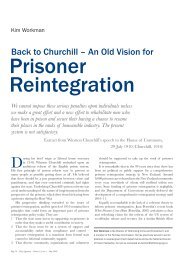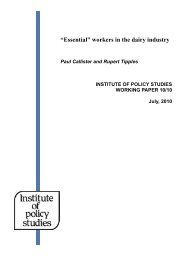PDF File - Institute for Governance and Policy Studies - Victoria ...
PDF File - Institute for Governance and Policy Studies - Victoria ...
PDF File - Institute for Governance and Policy Studies - Victoria ...
You also want an ePaper? Increase the reach of your titles
YUMPU automatically turns print PDFs into web optimized ePapers that Google loves.
Provoking Debate <strong>and</strong> Learning Lessons: it is early days, but what does the Per<strong>for</strong>mance Improvement Framework<br />
challenge us to think about<br />
Prime Minister <strong>and</strong> Cabinet, Maarten<br />
Wevers, travelled to the UK to meet with<br />
the British Cabinet secretary, Lord Gus<br />
O’Donnell. The origins of PIF lie in their<br />
discussions. On their return Rennie <strong>and</strong><br />
Wevers commissioned a team from across<br />
the state services to take the best of the UK<br />
Capability Review Programme <strong>and</strong> the<br />
best of the organisational improvement<br />
models from the New Zeal<strong>and</strong> private<br />
sector, as well as methodologies from<br />
other jurisdictions, <strong>and</strong> adapt them to the<br />
New Zeal<strong>and</strong> public management system<br />
(State Services Commission, 2012a).<br />
What are the early benefits<br />
From the PIF process the central agencies<br />
get a picture of what is good about the<br />
New Zeal<strong>and</strong> public management system<br />
<strong>and</strong> what needs to improve. Central agency<br />
officials would frequently be asked, ‘Who<br />
is good at financial management’, or<br />
‘Who is good at setting strategy’ Up until<br />
now there has been no way they could<br />
point to the areas of demonstrable <strong>and</strong><br />
evidential strength. Now they can. Be<strong>for</strong>e<br />
PIF, everyone had their own anecdotes<br />
about what needed to be done better. For<br />
central agency officials, PIF gives a systemwide<br />
diagnosis about what is being done<br />
well <strong>and</strong> where the system can improve.<br />
In addition, ministers get assurance that<br />
the agencies they are responsible <strong>for</strong> are<br />
constantly looking to improve how they<br />
do business <strong>and</strong> deliver value <strong>for</strong> the<br />
taxpayers’ investment in them. Ministers<br />
also get independent assurance, as the PIF<br />
<strong>for</strong>mal reviews are undertaken by external<br />
expert parties. Finally, <strong>and</strong> probably most<br />
importantly, the public is able to see that<br />
the state services are on the move <strong>and</strong> are<br />
serious about the services they deliver <strong>and</strong><br />
how these are delivered: the public can see<br />
that the state services are continuously<br />
seeking to improve <strong>and</strong> are transparent<br />
about that journey.<br />
What is the intervention logic<br />
At the heart of the PIF is the intervention<br />
logic (<strong>and</strong> design assumption) that an<br />
ethical <strong>and</strong> impartial state service is<br />
fundamental to maintaining trust, but<br />
integrity <strong>and</strong> impartiality, while necessary,<br />
are not sufficient to maintain confidence<br />
in New Zeal<strong>and</strong>’s public institutions<br />
(State Services Commission, 2011a). Public<br />
institutions need to deliver – they need to<br />
per<strong>for</strong>m – <strong>and</strong> they need to demonstrate<br />
to citizens that they take per<strong>for</strong>mance<br />
improvement seriously. The value of PIF<br />
is that it was designed to support public<br />
institutions to improve <strong>and</strong> demonstrate<br />
a commitment to per<strong>for</strong>mance improvement.<br />
After being redesigned<br />
over the past 12 months,<br />
PIF is now a method <strong>for</strong><br />
systematically identifying<br />
the extent to which an<br />
agency underst<strong>and</strong>s its<br />
role <strong>and</strong> purpose <strong>and</strong><br />
determining how<br />
it is led, managed <strong>and</strong><br />
resourced<br />
PIF system analysis: difficulties <strong>and</strong><br />
technical hitches<br />
So, what role does the PIF play in enabling<br />
a high-integrity <strong>and</strong> high-per<strong>for</strong>ming<br />
state sector After being redesigned over<br />
the past 12 months, PIF is now a method<br />
<strong>for</strong> systematically identifying the extent<br />
to which an agency underst<strong>and</strong>s its role<br />
<strong>and</strong> purpose <strong>and</strong> determining how it<br />
is led, managed <strong>and</strong> resourced (State<br />
Services Commission, 2012d). Three<br />
years ago it was simply an organisational<br />
diagnostic tool; now it is a process<br />
designed specifically <strong>for</strong> the New Zeal<strong>and</strong><br />
state services to ensure chief executives<br />
<strong>and</strong> senior leaders have well-developed<br />
views on the most important issues facing<br />
New Zeal<strong>and</strong>, what it will take <strong>for</strong> their<br />
particular agency or sector to address<br />
those issues, <strong>and</strong> the role each agency <strong>and</strong><br />
sector can <strong>and</strong> should play.<br />
How does the PIF system analysis now<br />
under-way in the central agencies add to<br />
the collective knowledge How does it<br />
help ministers, agencies, stakeholders <strong>and</strong><br />
the public underst<strong>and</strong> the functioning<br />
<strong>and</strong> per<strong>for</strong>mance of the state sector<br />
The three purposes <strong>for</strong> which PIF was<br />
set up are to:<br />
• help chief executives drive<br />
improvements in agency <strong>and</strong> crossagency<br />
per<strong>for</strong>mance;<br />
• give ministers, stakeholders, <strong>and</strong> the<br />
public assurance about current levels<br />
of agency <strong>and</strong> system per<strong>for</strong>mance,<br />
<strong>and</strong> progress on improving both; <strong>and</strong><br />
• give central agencies a coherent view<br />
of agency <strong>and</strong> system per<strong>for</strong>mance<br />
<strong>and</strong> position central agencies to<br />
prioritise <strong>and</strong> drive improvements.<br />
(State Services Commission, 2011b)<br />
The PIF system analysis plays a part<br />
in all three purposes, but primarily, in<br />
the last one. Some early results of this<br />
analysis will be discussed below, but<br />
first some technical limits <strong>and</strong> pitfalls<br />
of the analysis need to be recognised.<br />
First, a PIF agency review is not an audit,<br />
scientific evaluation, an investigation of<br />
compliance or an accreditation process.<br />
Rather, it is an integrated, deep, fast <strong>and</strong><br />
independent review of an agency’s fitness<br />
<strong>for</strong> purpose <strong>and</strong> indicates how well placed<br />
that agency is to deal with the issues that<br />
confront it in the near future. Moreover,<br />
the report is published, as are all on the<br />
State Services Commission website. The<br />
method of enquiry is mixed. Quantitative<br />
<strong>and</strong> qualitative analyses are used, often in<br />
combination with desktop analysis <strong>and</strong><br />
one-on-one interviews <strong>and</strong> focus groups<br />
which use the methods of appreciative<br />
enquiry <strong>and</strong> strengths-based analysis<br />
(State Services Commission, 2012a) –<br />
these are focused on internally-driven<br />
organisational learning. PIF also has the<br />
advantage of integrating publicly-available<br />
per<strong>for</strong>mance in<strong>for</strong>mation <strong>and</strong> internal<br />
management in<strong>for</strong>mation from the State<br />
Services Commission, the Treasury <strong>and</strong><br />
the Department of the Prime Minister<br />
<strong>and</strong> Cabinet (State Services Commission,<br />
2012b). Finally, the reviews themselves rely<br />
on a peer review, <strong>and</strong> the ratings are a set<br />
of judgements about an agreed, though<br />
unknown, future state. In that respect, the<br />
PIF process is ‘heuristic’ (Ryan, 2004), one<br />
through which agencies learn their way<br />
<strong>for</strong>ward through collective dialogue <strong>and</strong><br />
internal reflection.<br />
Page 30 – <strong>Policy</strong> Quarterly – Volume 8, Issue 4 – November 2012













